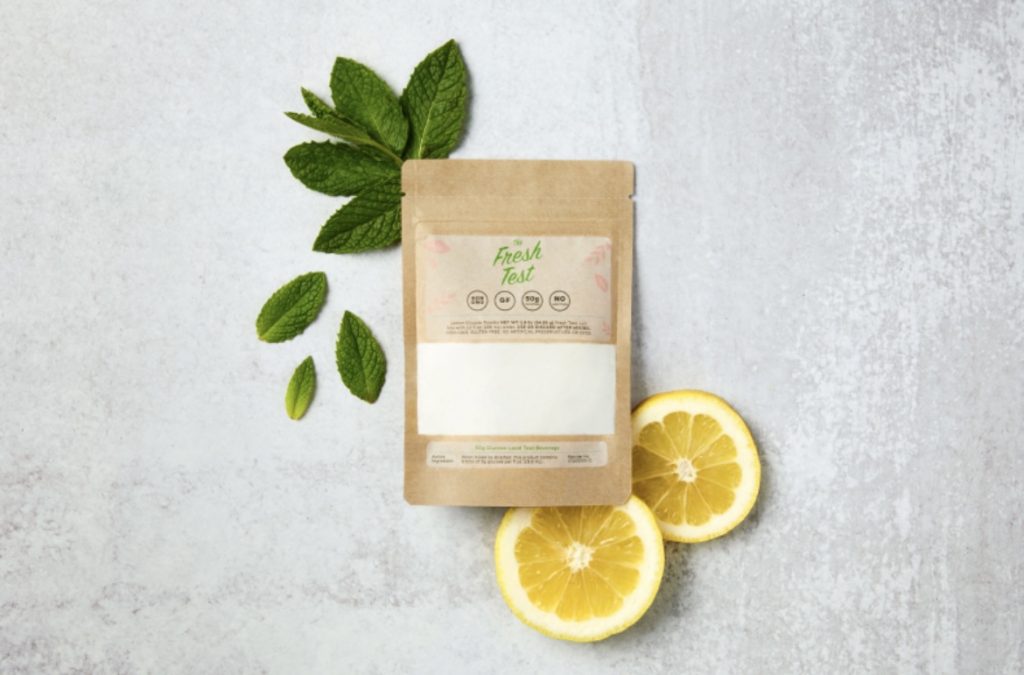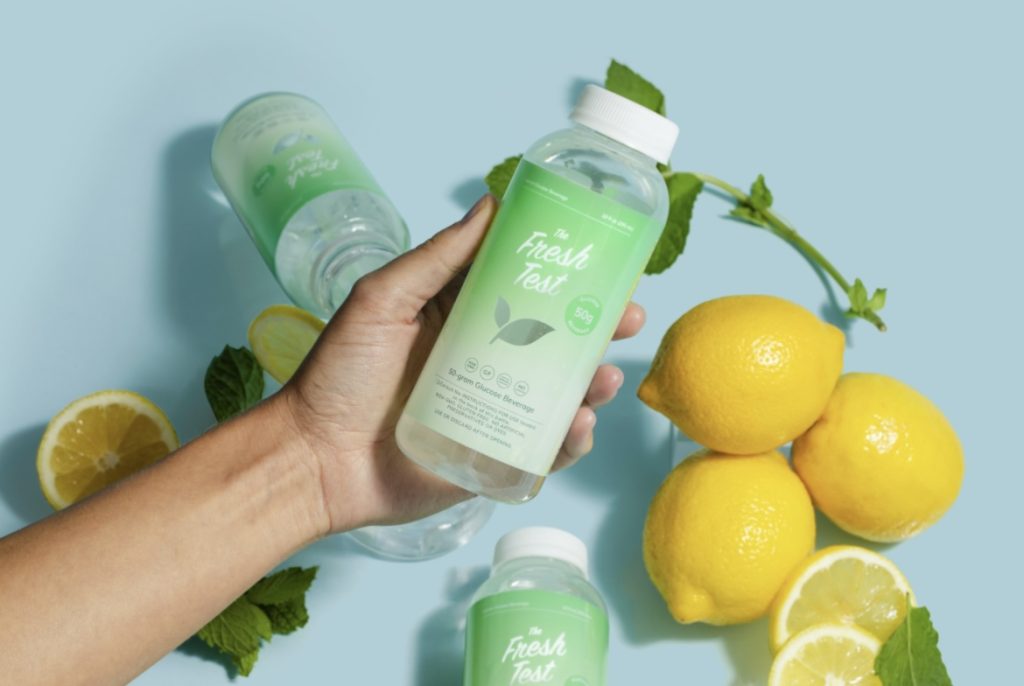
Most pregnant women go in to their medical provider between 24 and 28 weeks to take their glucose screening test. Most women are offered either fruit punch, lemon-lime, or orange flavored glucola drinks. However, the glucola drink isn’t your only option when it comes to the glucose test. There is a less known, more natural, clean alternative glucose drink called The Fresh Test.
What is the glucose test?
The glucose screening test is a “routine” test that most women take at the end of their second trimester or the beginning of their third trimester. The purpose of this test is to check for diabetes that develops during pregnancy, known as gestational diabetes.
How is the test administered?
Your doctor or midwife will give you a sugary drink to take one hour before a blood draw. This test measures the body’s response to sugar (also known as glucose) to rule out gestational diabetes.
What is in glucola drink?
The sugary drink they typically provide to perform the glucose test is known as the Glucola drink. Let’s break down the ingredient list of the Glucola drink:
- Dextrose
- Citric acid
- Artificial flavoring
- Sodium benzoate
- Red dye number 40
- Purified water
At a glance, these ingredients seem harmless. They appear on so many of our food labels that you may not even think twice about them. But within this drink are highly concentrated amounts of each of these ingredients, the amount of each ingredient is what causes me to take a step back and rethink taking it. Let’s look at some of the side effects of these ingredients.
- Dextrose: dextrose is the “blood-sugar-spiking” part of the glucose drink. Dextrose is a simple sugar made from starch (usually corn). Corn is heavily sprayed before it’s ripened in the fields. A farmer has to protect his crop from bugs, diseases, and birds. The easiest way they do that is by spraying the fields with pesticides regularly. Because of the pesticides, corn is usually filled with chemicals. Unless the label specifically says that it is organic or non-GMO, your dextrose probably comes with pesticides on the side.
- Citric acid:The natural form of citric acid naturally occurs in citrus fruits. However, the synthetic version of citric acid derives from a type of mold. It is then used as an additive in many foods and nutritional supplements as a preservative. While the synthetic form isn’t necessarily “bad”, it is definitely not as pure as the naturally occurring form, and may have some side effects. Some people find themselves having allergic reactions, nausea, stomach pain, swelling, stiffness, and shortness of breath. Not everyone experiences these issues, but again, it is nice to know the effects these things may have on your body before you put them into your body.
- Artificial flavoring: I personally am not a fan of artificial flavorings. The reason is, anything labeled as artificially flavored is chemically altered to taste a certain way. Not only can eating artificially flavored foods lead to nutrient deficiency, but they can also trick your brain into thinking you have consumed a food without actually eating it. For example, let’s say you eat something that is watermelon flavored versus eating an actual slice of watermelon. The vitamin and mineral content in the flavored food is obviously much lower than that of the actual watermelon slice. You are no longer craving watermelon since your body thinks you already ate it, but you missed out on the nutrients in the natural form of the food. Altering foods in general, can cause a plethora of issues, but chemically altering your food to taste a certain way most definitely carries potential health risks. A few of these risks are nausea, gastric issues, asthma, sleep issues, kidney damage, hyperkinesis, skin rashes, migraines, cancerous tumors, hyperkinesis, and learning disabilities.
- Sodium benzoate: Sodium benzoate is a preservative commonly used in foods. But is it safe? I think not. Some studies have shown that sodium benzoate can contribute to hormone disruption, reduced fertility, mutagenic effects, oxidative stress, neurological diseases, and depression. What really gets me about this ingredient is that it is literally used in toothpaste, grease lubricants and antifreeze. Yet someone thought it was ok to put this in a drink that we routinely give to pregnant women. I don’t understand… I just don’t.
- FD and C red #40: There are certain ingredients used in American food that are not allowed in other countries because of how harmful they can be to our bodies. Food dyes are one of them. Each food dye comes with a variety of physical/medical issues. Red dye #40 can cause many issues such as jitteriness, migraines, an upset stomach, inability to concentrate, and nervousness. This drink does not just contain a tiny bit of red dye, it contains quite a bit of it. If you opt for the orange flavored drink instead, you still end up with red dye #40 and then yellow 5 dye as well. Yellow 5 is best known for causing tumor growth, diseases like cancer, blurred vision, migraines, fatigue, and anxiety. All around a no-go for me.
- Purified water: thank goodness for this ingredient, at least one of these ingredients is better than the others, ha ha!
if I read a label in the store that had these ingredients and their side effects listed on the back, I don’t think I would consider drinking it anytime, but especially not when I’m pregnant! Yet this drink is routinely given to pregnant women.
But don’t fret, there are other options when it comes to having a glucose screening test done. My favorite is The Fresh Test.

Ingredients of the fresh test
I really appreciate the Fresh Tests’ short list of ingredients. The shorter your list of ingredients, the less garbage the drink will contain. This list is short, practical, and easy to understand.
Ingredients:
- Non-GMO dextrose
- Crystallized lemon
- Organic peppermint leaf powder
Now, let’s break down these ingredients.
- Non-GMO dextrose: unlike regular dextrose, this dextrose is non-GMO. Which means it was not heavily sprayed with pesticides and chemicals. So therefore it does not come with all the extra harmful chemicals used on the corn that the dextrose is derived from.
- Crystallized lemon: the reason this lemon is crystallized is the fresh test comes in a powder form. This crystallized lemon is broken down into three ingredients: lemon juice, lemon oil, and citric acid. Unlike the citric acid in the glucola drink, this citric acid is the naturally occurring form derived straight from a lemon. The lemon juice is also naturally occurring straight from the lemon’s pulp, and the lemon oil is naturally occurring straight from the lemons skin.
- Organic peppermint leaf powder: Organic peppermint leaf is dried, blended, and milled down into a cool minty powder. In this drink, it is used to help offset the nausea inducing effects of the dextrose. Smaller9, unconcentrated amounts of peppermint are generally safe for you, your baby, and your pregnancy, but be sure to double check any and all herbs and spices with your doctor or midwife before consuming them.
How do I take the fresh test?
Unlike the glucola drink, the fresh test does not come premixed. The drink mix is a powder form that you dump into 10 ounces of cold water and consume one hour before your blood glucose blood draw.
What if I fail my glucose test? Is there another Fresh Test option for a re-test?
If you fail your glucose test, your provider will generally have you come back in to take another test with a different strength drink. The fresh test offers a 50 g drink (which is the drink most women will need), a 75 g drink and a 100 g drink (for women who failed the first 50 g test). If you fail your first test, definitely run these other options by your medical provider.
What if your medical provider doesn’t know about the test?
Many providers and laboratories are now familiar with the fresh test. If you mention it and they don’t know what it is, send them to the fresh test’s website resources webpage, and have them check it out! If their laboratory doesn’t stock the fresh test yet, you can also order it online ahead of time and have it ready when it’s time to go take your test.
In conclusion,
Taking one test instead of another is a completely personal preference. Not everyone will think the fresh test is necessary, and will opt for the regular glucose drink. There are other women who prefer a cleaner option, and will always opt for the fresh test when considering the blood glucose test . There is no right or wrong answer, but my personal recommendation is to try the fresh test for this blood draw. Our bodies are natural toxin filters, but pregnancy puts a lot of extra strain on your kidneys, liver, etc. Think about giving your body a break from all the filtering, and try out the fresh test!
Whatever you choose, I’m sure it will be the right decision for you, your body, and your baby!
Disclaimer: All content and media on the Creating a Better Birth website is created and published online for informational purposes only. It is not intended to be a substitute for professional medical advice and should not be relied on as health or personal advice. Always seek the guidance of a qualified health professional with any questions you may have regarding your health or a medical condition. Never disregard the advice of a medical professional, or delay in seeking it because of something you have read on this Website.
If you think you may have a medical emergency, call your doctor or call emergency services. If you choose to rely on any information provided by Creating a Better Birth, you do so solely at your own risk.
